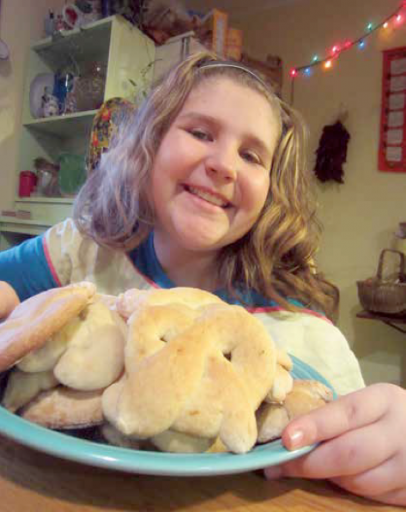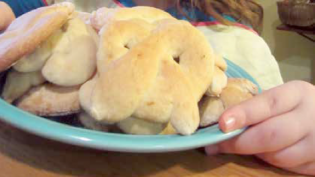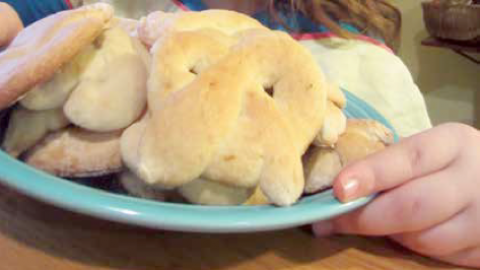The Genealogy of a Kringla
Growing up, our world in central Iowa was very small. It consisted of a few gravel roads, a crick too small to name that ran north into Beaver Crick, and then into the Des Moines River.
Everyone had a well with a pump and an outhouse; and tar paper was what crummy vinyl siding is today. All of the men had jobs, even if they had to walk five miles there and back every day, black lunch bucket and thermos in hand. And some did. And in that very different time from now, most of the women stayed home wrangling kids and managing the household. We lived in what was called Dogpatch, a small unincorporated spot of earth just north of Des Moines. It’s still there, with its windy roads constructed not by an architect or planner, but more likely first crafted by deer trails, then cow paths.
When I was a kid, we thought our neighborhood was called Dogpatch because there were dozens of nearly feral dogs that roamed singly and in packs. In truth, it was called Dogpatch after the popular Al Capp fictional comic strip “L’l Abner (which ran from 1934-1977),” where shantytown “hillbillies” conducted their affairs to the amusement of the newspaper reading public. I understand that Dogpatch isn’t called Dogpatch anymore, because the name is seen as “insensitive.” We didn’t really mind the “Dogpatch” label. We were sort of a shantytown, and we didn’t have much money, but if you dared use an epithet common at the time--”poor white trash”-- it would have been a mistake, as we’d a kicked your ass. We weren’t “poor white trash,” but we resembled them.
We had little land; we saw landed farmers as rich. But the men had real jobs. Carpenters, bricklayers, mechanics. Women had little opportunity beyond the household, and some of them thrived, while some to this day bear much anger about the opportunities denied them in that so-called idyllic time. And we kids roamed almost as much as the dogs, and I and my buddies dreamed someday that we might have jobs when we grew up that kept us out of the Iowa bitter cold and extreme heat--like a good janitor job at the school.
While I was growing up I always felt that I was in sort of an ethnic void. Neither language, costume, or food distinguished us from one another. Neither did religion. Many of us were Lutheran, if we were churchy at all. As the readers of Edible Iowa River Valley know, food is at the core of all cultures, and our bland food had no discernable ethnic nor historic connection. Neither did we.
Recipes were taken out of my mom’s old Betty Crocker cookbook, out of the occasional Better Homes and Garden’s magazine, or off of the label of a can. We were close enough in time to the period before refrigeration that store-bought canned food was still seen as a miracle. Gardens were common, and food was home-canned, of course. But the actual purchase of canned food was seen as more prestigious and modern than fresh food, the opposite of thoughts today, at least by foodies.
When I was a teenager, I met a few Italians with their rich culinary history, and I knew something was missing from our lives--a cultural connection that food reinforces. But it was only when a kind Jewish family moved nearby and welcomed me to their table, that I first realized how culturally deprived we were. It was food that led me to that recognition, when they fed me knish, gefilte fish, goulash, matzah balls, chicken soup, lox and bagels, among other traditional Jewish foods. Significantly, each of these foods came with stories attached, that every family member knew and shared across generations.
We simply had nothing like it. Both my paternal grandparents were half Ioway, and it showed physically in my father, aunts and uncles’ black hair and dark brown skin, and in the epicanthic eyefolds that pop up regularly, all the way down to my children --but not so much culturally. There was lots of woodlore and game on grandpa and grandma’s tables that one might expect on traditional Ioway tables, but really not that much different from what was on other hunter’s tables at the time--deer, squirrel, and rabbit found their way into other homes in Dogpatch. So, to my young mind we had virtually nothing. No cuisine, no history, no culture--nothing that rooted us anywhere in place or time except for one place--Dogpatch.
Well, not exactly nothing. We had one hope, one slim thread of culture, one item of cuisine that emerged only during the holidays, that rooted us to another place and a time, and importantly, to a people. In sum, fare that proved a gateway to another world that was the root of a maternal line identity. That slim bit of culture, the food that gave us just a touch of history and identity was the beloved Scandinavian kringla, or kringle, a pastry that had its origin with Roman Catholic Monks who arrived in Norway in the 13th Century. We called ours kringlas, and while there are a great number of variations, including sweet, salty, or filled pastries, ours was a baked and browned sweet--but not too sweet, pretzel shaped, thick, cookie-like pastry.
Our beloved kringlas were passed down from my grandma Fenner, nee Sydnes, whose ancestors were among the first settlers in Story County. They arrived at the spot where they built a town called Palestine on the 7th of June, 1855 with their entire congregation of Synod-Lutherans. They saw their new home--Iowa-- as a land of milk and honey where they could find religious freedom. While the Sydnes’ were among those early settlers, I suspect that kringlas were passed down the maternal line. Grandma Fenner’s great-grandmother was Siri Jan Henricksdotter. Grandma Hendricksdotter was born in 1835 on the Næs Yttre Farm, Søndre Bergenhuus, Skånevik Parish, Hordaland, in Norway. In 1849, when she was 14, she emigrated to the US, on the same ship--the Favorite-- as her future husband. Presumably, she brought her mother’s kringla recipe with her.
Kringlas appeared like clockwork at Thanksgiving and Christmas at Grandma Fenner’s house. The big meal, however, was uneventful--as I am sure it was for many midwesterners at the time. Store bought turkey for Thanksgiving, ham for Christmas, mashed potatoes (morphing later as food technology “advanced” into potatoes “au gratin” from a box), green bean casserole (with the French’s® French Fried Onions on top) a wide variety of Jello® and marshmallow “salads,” Wonder Bread® “baked” rolls, and of course the obligatory cranberry-like substance from a can, still bearing the can impressions when served. All blissfully presented with love.
But I can remember it like it was yesterday, the women--all wearing aprons and working in a cooking frenzy--pulling Grandma’s kringla dough out of the refrigerator (after chilling overnight), and laughing as they twisted the dough into pretzel shapes before baking. The baking didn’t take long, and the hot buttered kringlas were eaten fresh out of the oven and then again for dessert. There was nothing like it, and we crowded Grandma’s red formica topped table for our first kringla of the holiday. Flavor--as well as history and ethnicity--warmed our hearts.
And I assure you, that at the Leonard family table this Christmas, along with the wonderful traditional fare my lovely New Mexican wife, Annie will create, our children will hear stories of their New Mexican heritage as they eat that food they know well and love. They’ll also hear stories of their great, great, great, great Grandmother Siri Jan Henricksdotter, who sailed the Atlantic Ocean in the ship Favorite at the tender age of 14 to seek freedom and a new life in Iowa. As they eat her kringlas.







